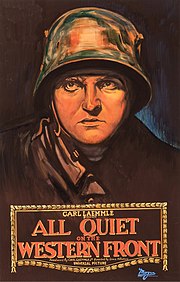
A film genre is a type of category of motion-pictures. The term "genre" has been used to organize films since the earliest days of cinema. [1] However, genres are easier to recognize than to define and cannot be identified in a rigid way. [2] The concept of genre is inherited from literature and theater. Some of the genres themselves are also inherited, [3] [4] such as westerns (from literature) and musicals (from theater). Audiences may find genre films more familiar and understandable, while producers consider them safer investments, easier to make, and easier to market, [3] especially when a genre has a devoted fanbase with supporting publications such as websites and magazines. [5]
Genres change over time, and some genres may largely disappear (for example, the melodrama). [1] The perceived genre of a film can also change over time. For example, The Great Train Robbery (1903) is seen as a key early Western film, but when it was released it might have been described as a "chase film". [3] Some genres overlap such as spy films and action films, while parodies appropriate elements of other genres for comedic effect. [1]
Conventions and Iconography

The common elements that bind a genre together could be almost anything. Below are a few examples of the features that might identify a certain genre. This list should not be considered exhaustive.
- Archetypal characters [3]
- ...such as the hard-boiled detective and femme fatale in film noir
- Certain actors
- ...sometimes acquire a reputation linked to a single genre, such as John Wayne in the Western or Fred Astaire in the musical. [3] [4]
- Setting [1] [3]
- e.g. war films, Westerns, and space operas
- Lighting [3]
- Framing [3]
- Costumes [3]
- Title Fonts [3]
- ...such as rough-hewn logs for Western films or "scrawled" writing for horror movies
- Scoring conventions [3]
- ...such as lush string orchestras for melodramas or electronic music for sci fi
- Target audience [1] [4]
- e.g. kid's movies
- Budget [1] [4]
- e.g. B movie, Blockbuster, or low-budget film
See also
References
- ^ a b c d e f Hayward, Susan. "Genre/Sub-genre" in Cinema Studies: The Key Concepts (Third Edition). Routledge, 2006. p. 185-192
- ^ Thompson, Kristin; Bordwell, David (2012-07-06). Film Art: An Introduction. McGraw-Hill Education. ISBN 9780073535104.
- ^ a b c d e f g h i j k Grant, Barry Keith. Film Genre: From Iconography to Ideology. Wallflower Press, 2007.
- ^ a b c d Stam, Robert (2000-02-21). Film Theory: An Anthology. Wiley. ISBN 9780631206545.
- ^ Truby, John. "What's My Genre?". Writers Store. Retrieved 2007-07-31.
Further reading
- Friedman, Lester et al. An Introduction to Film Genres. New York: W. W. Norton & Company, 2014 ISBN 978-0-393-93019-1 609p.
- Grant, Barry Keith. Film Genre Reader I, II & III. Austin: University of Texas Press, 1986, 1995, 2003
- López, Daniel. Films By Genre: 775 categories, styles, trends, and movements defined, with a filmography for each. Jefferson, N.C.: McFarland & Co., 1993 ISBN 0-89950-780-8 495p.
- Summers, Howard. The Guide To Movie Lists 2: Genres, Subjects and Themes. Borehamwood: Howcom Services, 2018 ISBN 978-1-982904-72-2 418p.
External links
- Genres of film at the Internet Movie Database
- Genres and Themes, BFI screenonline
- Finding Books on Film Genres, Styles and Categories, Yale University Library
- "A Guide to Classic Movie Genres and Styles" by Laurie Boeder, thoughtco.com
- JSTOR "A Semantic/Syntactic Approach to Film Genre", by Rick Altman SCRIBD academia.edu (PDF)
- JSTOR "Review: Film/Genre by Rick Altman", by Leger Grindon
- Park W. What Is Film Noir? [e-book]. Lanham, Md: Bucknell University Press; 2011. Available from: eBook Collection (EBSCOhost), Ipswich, MA. Accessed November 19, 2017.